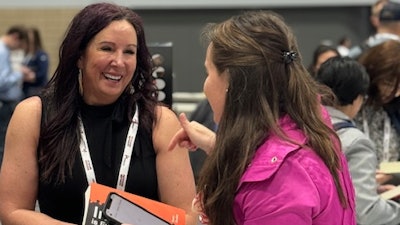
Tamara Ghandour, founder of LaunchStreet and creator of the Innovative Quotient Edge (IQE) assessment tool, opened the second day of Petfood Forum with an interactive session where she shared her insights into an holistic approach to managing your team with neuroscience.
She noted that the term “innovation” can create a lot of confusion itself. “Everybody has different ideas about what it means,” said Ghandour. Through her experience over the last 25 years, she has created a definition that can make sense to anyone:
Innovation is thinking differently about what’s right in front of you to create an advantage.
“It’s really just taking what you have and putting a fresh, new light on it,” said Ghandour.
So, how do we unlock and access the ideas inside and pull them out?
“Being innovative is universal – anyone can do it,” said Ghandour. “How each of us does it is unique. The best way to be an innovator is to understand how you think.”
Elevating human potential is about discovering your strengths and playing to those. Managers can start with some basic questions: How do we understand human behavior beyond the job description? What drives them? What motivates them? How do we tap into their innovative minds? How do we help them overcome resistance to change?
Three hacks to get started
“We find the key to high performance and to drive motivation for ourselves in the team that we lead is all about rediscovering who we are and what our strengths are then amplifying that,” Ghandour said. She offered three quick hacks to help elevate the human potential on your team.
1. Ask inciting questions
Questions in, answers out, said Ghandour, is the typical conversation. Where we start is where we end, which can get us stuck. “Ask questions that stir the pot,” she said. Because asking inciting questions feels uncomfortable, she offered these suggestions to get started:
- If we didn’t do what we usually do, how would we tackle this?
- If our biggest competitor/client solved this problem, what would they do?
- What’s the smallest possible change we could make that would have the biggest impact?
- How do we rearrange the box to create new value or opportunities?
- What’s the problem that caused the problem? Now solve the problem.
2. Get past the internal resistors to change
Humans are resistant to change for two reasons, said Ghandour. These include our reticular activating system (we let in only what we already believe) and our lizard brains (which keeps us safe, but we don’t want to change).
“People don’t fear change, they fear being changed,” said Ghandour. “This often happens subconsciously, so some don’t even know it’s there.”
Ghandour suggested when meeting with resistance, to ask the person, “tell me more.” This helps those who are resistant talk through their reasons and get away from their confirmation bias and lizard brain.
3. Use "and" to foster collaboration
“One word shuts down people,” said Ghandour. “’But’ shuts down collaboration.”
The word ‘but’ negates everything that came before it. It’s like telling the person, “You’re wrong.”
“’But’ stops conversation and can be perceived as combative,” said Ghandour. “We have to get out of the habit.”
If you want to drive and amplify human capital, try using “and” which helps foster a more constructive debate. “And,” said Ghandour, builds on what comes before it and tells the other person you respect their ideas.
“’And’ fosters conversations,” she added. “It shows openness and confidence.”


















